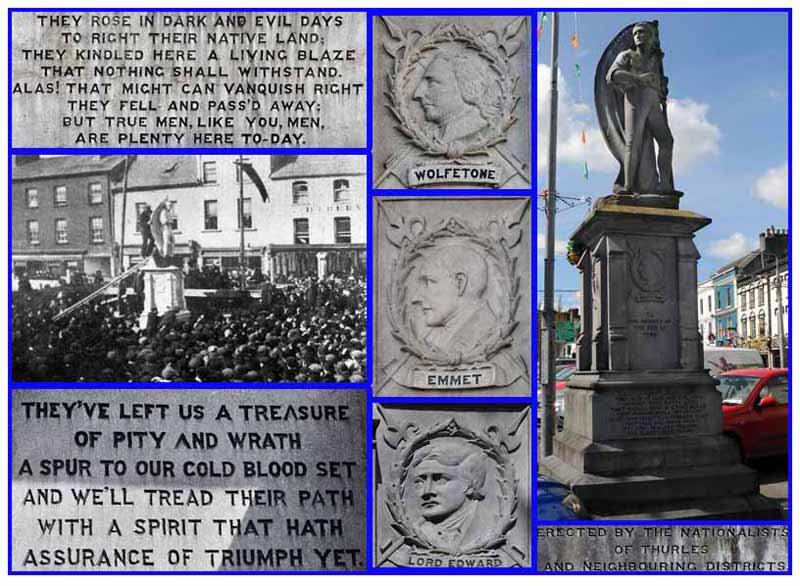The 1798 monument today positioned in Liberty Square, Thurles, Co Tipperary, is affectionately referred too, most often, as simply ‘The Stone Man’.
In the hustle and bustle of everyday 21st century living here in Thurles and mindful of hefty parking charges and indeed a not insignificant fine for those found remiss in failing to visit a parking meter; very few local people today take the time to ‘stand and stare’, while contemplating the truth of its existence.

The ‘Stone Man’ was first unveiled in 1901 (See old photograph of the official unveiling above) to commemorate the first centenary of the ill fated attempt at a rebellion in 1798. Funding to pay for this very fine monument and indeed its eventual erection, was collected voluntarily from the nationalists of Thurles and surrounding districts. However full funding came some three years too late to actually commemorate this first centenary event.
Indeed many would have believed that the wording on this monument could hardly have been acceptable to local authorities, (See nationalist rhyming principles being propagated in above picture), then subject to strong British rule.
However it would appear that those then in power felt more fear from banning this structure, than in allowing its erection. On the other hand this monument was erected to the memory of three Protestant 1798 wealthy nationalist leaders, in a town (Thurles), described in the British Parliamentary Gazetteer of 1846 as being “decidedly the most Roman Catholic town in Ireland, second only to the city of Galway.”
The Protestant Leaders Commemorated by the ‘Stone Man’ in Liberty Square, Thurles, Co. Tipperary.
(1) Theobald Wolfe Tone, (20 June 1763 – 19 November 1798), today referred to by his sir-name Wolfe Tone, then a leading Irish revolutionary figure and one of the five founding members of the Society of United Irishmen, aimed at a political union between Catholics and Protestants, and is regarded today as the father of Irish Republicanism and the true leader of the 1798 Irish Rebellion.
Wolfe Tone was born in Dublin, the son of a Protestant coach-maker, who also owned a farm near Sallins, in Co. Kildare. His mother who came from a Catholic merchant family, chose to convert to Protestantism, following Theobald’s birth. Educated at Trinity College, Dublin, he qualified as a barrister in King’s Inns at the age of 26 and attended the Inns of Court in London.
(2) Robert Emmet (4 March 1778 – 20 September 1803) was a Protestant; an Irish nationalist; Republican; an orator and rebel leader, who led an abortive rebellion against British rule in 1803.
Emmet was born at No. 109, St. Stephen’s Green, Dublin and was the youngest son of Dr Robert Emmet a wealthy court physician and his wife, Elizabeth Mason. Again educated at Trinity College, Dublin, before being expelled in 1798, and forced to flee to France.
Emmet was captured following his failed Dublin rebellion; was tried for treason and sentenced to be ‘hanged, drawn and quartered’, as was customary for any conviction of treason. He was hanged and once pronounced dead, was beheaded in Thomas Street near St. Catherine’s church in Dublin. Family members and friends failed to come forward to claim his final remains, out of fear of arrest, so alas today we cannot identify, in truth, his last resting place.
(3) Lord Edward FitzGerald (15 October 1763 – 4 June 1798), also a member of the Society of United Irishmen and was part of the Protestant Ascendancy; being the fifth son of Lieutenant-General James FitzGerald, 1st Duke of Leinster; an Irish aristocrat; revolutionary, who died of wounds received while resisting arrest on a charge of treason.
FitzGerald spent most of his early years at Frescati House, Blackrock, Co. Dublin and was privately educated here by a private tutor named William Ogilvie.
Details of these three Irish republican leaders and their involvement in the intervening years, up to their eventual deaths in 1798 and 1803, can be easily accessed online or from your local library.
So why then was a memorial to the 1798 rebellion erected in Thurles; a town and indeed a county who took real, little or no part in this same rebellion?
Watch out for our explanation, in a forthcoming blog, over the coming days.

Brilliant, informational and factual. No harm to educate those who, even today, would still cast aspersions on our Protestant or Church of Ireland brethren.